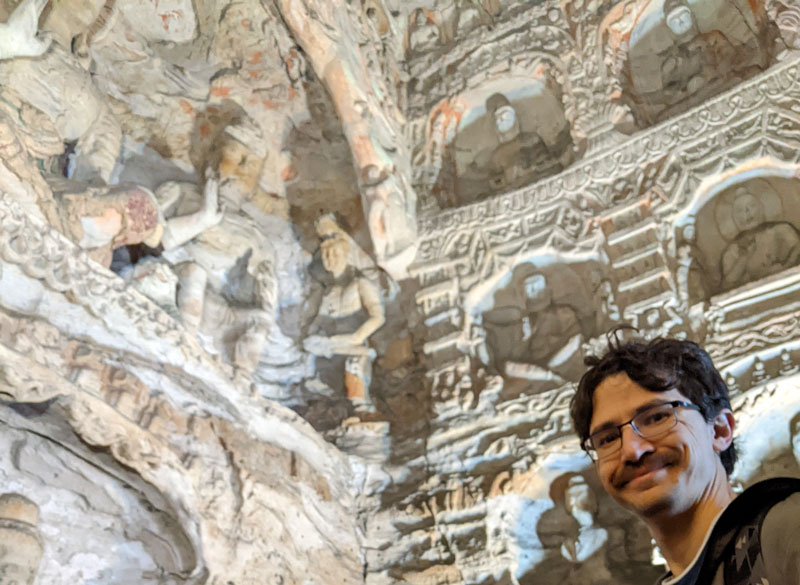Background and expertise
My teaching and research interests are varied, but I started off as a global historian who focuses on cultural exchanges in Asia in the early twentieth century. More recently, I have been exploring the history of the internet and surveillance. I have been teaching in one form or another since 2011 and started at Naz in 2022.
My academic passion
There are so many inspiring people from the past who faced challenges both mundane and life-threatening, yet they found ways to not just persevere, but find joy and purpose. I love sharing their stories with students, and I love it when students share stories with me. I want students to see themselves in the curriculum and see themselves in society because folks like us played a critical role in shaping history, and we will continue to play a role in shaping the future.

Phillip Guingona shares information in his ancient Asian history classes from his travels, including what he saw at Yungang Grottoes, outside of Datong, Shanxi, on the far eastern end of the old silk road, near the Chinese capital of Beijing. The massive complex contains a temple, a Ming Dynasty fortress, and many caves with Buddha carvings and paintings.
Courses I teach
- World War II
- Asian American History
- Sports History
- Politics and History of the Internet
- Writing Off Imperialism: A History of Modern Southeast Asia through Anti-Imperial Texts
- Modern China
- Women, Gender, and Sexuality in Asian History
- Historical Methods
- PE.Q Asian History to 1644
- PE.Q Asian History from 1644
What makes Naz a Goldilocks campus
There are enough students and programs to provide a good variety of classes and activities, but not so many that you feel overwhelmed by the scale of everything. Professors and students get to actually know one another, and not just during their overlap at Naz, but after graduation and beyond. Plus, Naz is close to a medium-sized city that has just about all the amenities you could ask for — including a Filipino sari-sari store — while maintaining the atmosphere of a small-town community.
Amplifying activists
The voices of activists, radicals, and social justice advocates fill the reading lists of my syllabi and fill the seats in my classrooms. As a trained historian, I always make a point to assign inspiring and critical texts from the past, but as an activist who strives to ameliorate our world, I also try to direct projects and activities toward analyzing the present, engaging with the community, and changing the future.
How I bring subjects to life
In my Asian history from 1644 introductory-level class, we read a great book by a failed scholar named Shen Fu. In addition to discussing his struggles, we play a poetry game that he and his wife Yun played over 200 years ago. It is a simple game where contestants rewrite the ending of a famous poem and submit those to a judge who doesn't know who wrote which ending. Imagine students trying to outdo one another in a Qing-Dynasty-style poetry slam. It highlights our shared humanity across space and time, but it is also just a blast.
My advice on learning
There is no beginning or end to the learning process. Confucius once said 三人行必有我師焉, or "when three people go for a walk, there is a teacher among them." When you know more about something, you are a teacher, and when you know less, you are a student. This applies to learners in the classroom at Nazareth or citizens who are studying whom to vote for before the election. We all have something to teach, and we all have much to learn.
Student Perspectives
“I've had the wonderful opportunity to have Phillip as a professor for four semesters now, and I've learned so much in every one of his classes. He teaches about things that K-12 education, and even some colleges and universities, don't talk about nearly enough, such as Asian/Asian American history. His courses have allowed me to expand my personal, academic, and professional interests, and his support has been crucial in getting me to where I am now.”
— Wren Heron ’24, communication and media, who plans to pursue diversity, equity, and inclusion work after graduation
“Dr. Guingona’s knowledge, passion, and lesson structure create an informative, engaging, and fun classroom. He cares for his students, is always open to questions regarding material or assignments, and is consistently there to help students succeed. He has fostered my passion for Asian history and enhanced my development and confidence as a history reader, writer, and student.”
— Kyle Kuzniar ’26, history and inclusive adolescent education
Recent research projects
- China and the Philippines: A Connected History, c. 1900-1950 was published by Cambridge University Press in 2023. China and the Philippines explores different avenues of interaction, such as sports competitions, war, and commerce, that brought China and the Philippines together, and eventually tore them apart.
- Unsovereign Space is a peer-reviewed undergraduate-level education module created for History for the 21st Century. The module explores how different people interacted with, claimed, and contested space, including national borders, maritime trade zones, outer space, and cyberspace, from the fifteenth century to the present.